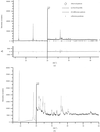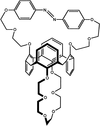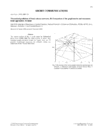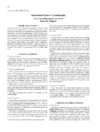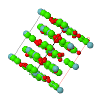issue contents
February 1999 issue

Cover illustration: An infinite hydrogen-bonded sheet in guanidinium trifluoromethanesulfonate. Courtesy of C. B. Aakeröy [Acta Cryst. (1997), B53, 569-586; structure determined by V. A. Russell, M. C. Etter & M. D. Ward].
research papers
Download citation


Download citation


Synchrotron X-ray diffraction images of the deformation electron density (Δρ) for two rare-earth orthoferrites RFeO3 (R = Nd, Dy) show a high degree of correlation between aspherical electron densities around magnetic R and Fe atoms in each compound, which can be related to the magnetic properties of these orthoferrites.
Download citation


Download citation


The ferroelectric-to-paraelectric phase transition in the lead hafnate titanate PbHf0.4Ti0.6O3 has been studied by temperature-dependent neutron powder diffraction. Particular attention has been directed towards the splitting of the Hf/Ti cationic site and the distortion of the oxygen octahedra.
Download citation


Download citation


Neutron structures of ammonium tetrafluoroberyllate at 200, 163 and 20 K reveal that both the BeF and the NH
and the NH ions rotate and shift positions upon going from the paraelectric to the ferroelectric phase, resulting in stronger hydrogen-bonding interactions in the ferroelectric phase accompanied by a doubling of the crystallographic a axis.
ions rotate and shift positions upon going from the paraelectric to the ferroelectric phase, resulting in stronger hydrogen-bonding interactions in the ferroelectric phase accompanied by a doubling of the crystallographic a axis.
Download citation


Download citation


Diffraction patterns of the high-temperature phases of the perovskites sodium niobate and sodium tantalate have been collected at intervals of 5 K using the high-resolution powder diffractometer HRPD at the ISIS neutron spallation source. This has allowed the structural changes with temperature within a single phase to be determined for the first time.
From the analysis of X-ray diffuse scattering, short-range order is indicated in CeInCu2. A superstructure-like disorder between Ce and In atoms is clarified; the feature is probably related to the fact that the structural disorder hardly affects the residual resistivity at low temperature.
Download citation


Download citation


Modelling and calculations by the maximum entropy method (MEM) have been used to solve the crystal structure of pentamethylcyclopentadienyllithium (LiCp*) from a high-resolution powder pattern. The structure was found to comprise polymeric `multidecker' chains. The pentamethylcyclopentadienyl anions are coplanar with each other and show threefold disorder.
Download citation


Download citation


The electron-density distribution in urea obtained by X-ray diffraction is compared quantitatively in direct and reciprocal space with the outcome of Hartree–Fock and density-functional solid-state calculations with different correlation and exchange potentials.
Download citation


Download citation


The crystal structures of 5,10-dimethyl-4,9-diazapyrene and the new compound 2,7-dimethyl-4,9-diazapyrene are presented and the experimental bond lengths are compared with those calculated by molecular mechanics and semi-empirical methods and values predicted by valence-bond and variable-electronegativity self-consistent field (VESCF) methods. The quantitative parameters of π π interactions have been calculated for two diazapyrenes and other pyrene-like molecules selected from the Cambridge Structural Database and used for classification of their crystal-packing types; the analysis is based on geometrical parameters and elements of electronic structure.
π interactions have been calculated for two diazapyrenes and other pyrene-like molecules selected from the Cambridge Structural Database and used for classification of their crystal-packing types; the analysis is based on geometrical parameters and elements of electronic structure.
Download citation


Download citation


The in situ crystallization and structure determination of the three title compounds is presented. The molecular geometries are in each case compared with the results of ab initio studies.
Download citation


Download citation


The accurate crystal structure of nicotinamide was determined from X-ray and neutron diffraction experiments. The electron distribution determined by the maximum entropy method indicates that the electrostatic properties depend on the rotation of the carboxamide group out of the pyridine plane.
Download citation


Download citation


The crystal structures of 2,6-naphthalenedicarboxylic acid and dimethyl 2,6-naphthalenedicarboxylate have been solved an initio, and refined (along with that of their precursor, 2,6-dimethylnaphthalene) using powder diffraction data.
Download citation


Download citation


Three polymorphic modifications of a calix[4]arene bis(crown) including an azobenzene unit have been structurally characterized. The phase transition between two of them was investigated by X-ray diffraction and adiabatic calorimetry.
Download citation


Download citation


L-Leu-L-Val forms non-isomorphous 1:1 solvates with methanol, ethanol (LVE) and 2-propanol (LV2P). LVE has four peptide molecules in the asymmetric unit, with intricate pseudosymmetry. LV2P retains the same hydrogen-bonding pattern as LVE with only half the unit-cell volume. This is owing to packing disorder resulting from four alternative peptide conformations.
Download citation


Download citation


The crystal structure of tripalmitin (PPP), a CnCnCn-type (n = even) triacylglycerol (TAG), was determined and used to build an overlap model for this type of TAG. From the model the crystal structures of the unknown members of this series are predicted.
The crystal structures of the α and β modifications of PTCDA were analyzed as projected structures on the (102) planes by electron crystallography using an imaging plate.
short communications
The correct version of Fig. 2> in the paper by Rutherford [Acta Cryst. (1998), B54, 204–210] is given.
international union of crystallography
Free 



 journal menu
journal menu
















